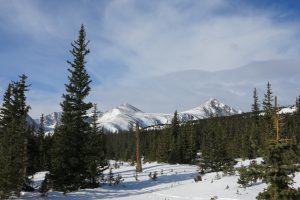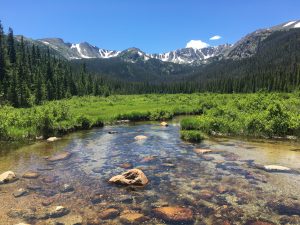4 August 2016
Earlier snowmelt carries drastic consequences for forests
Posted by Nanci Bompey
By Trent Knoss

A subalpine forest in Colorado’s Rocky Mountains.
Credit: Taylor Winchell / University of Colorado Boulder.
Earlier snowmelt periods associated with a warming climate may hinder subalpine forest regulation of atmospheric carbon dioxide, according to the results of a new study.
The findings, which were recently published in Geophysical Research Letters, a journal of the American Geophysical Union, predict that this shift in the timing of the snowmelt could result in a 45 percent reduction of snowmelt period forest carbon uptake by mid-century.
A separate study, also published in Geophysical Research Letters, found that earlier, slower snowmelt reduces the amount of streamflow, a phenomenon with potentially drastic consequences for agriculture, municipal water supplies and recreational opportunities in Colorado and other areas of the western U.S.
Forests located in seasonally snow-covered areas represent a key terrestrial carbon dioxide sink thanks to the natural photosynthetic processes by which trees uptake carbon. The trees’ carbon uptake is restrained during winter, but increases to peak capacity in spring when snowmelt provides sustained water input.
Working at the Niwot Ridge Ameriflux site in Colorado’s Rocky Mountains, University of Colorado Boulder researchers studied 15 years’ worth of snowmelt and atmospheric carbon dioxide data to study the effects of snowmelt periods. The research found that earlier snowmelt periods triggered by climate change align with colder air temperatures, reducing the forests’ ability to take carbon dioxide out of the atmosphere.
“This study shows us that, counterintuitively, warming generally causes snow to melt during colder periods of the seasonal temperature cycle due to the effects that warming has on reducing the depth of snowpacks, which causes melt to begin earlier in the year,” said Taylor Winchell, a graduate researcher in the Institute for Arctic and Alpine Research (INSTAAR) at CU Boulder, and lead author of the study. “The colder temperatures associated with early melt reduce the trees’ ability to uptake carbon during the snowmelt period, a key period for seasonal carbon uptake.”
“The implications of this research are quite profound as mountains in the western U.S. are an important part of the regional cycling of carbon and water,” said Noah Molotch, the director of the Center for Water Earth Science & Technology (CWEST) at CU Boulder, and a co-author of both new studies. “In this regard, earlier snowmelt will reduce carbon uptake in mountain forests, weakening the ability of forests to offset increases in CO2 associated with human burning of fossil fuels.”
Snowmelt also acts as a key hydrological driver for rivers and streams across the state, providing water resources to downstream communities. Previous research has suggested that the timing and rate at which snow melts can impact the amount and quality of water available for vegetation, farming, and fishing.
The researchers used a unique modeling system to study the effects of earlier snowmelt across various regions of western United States including the Cascade range, the Sierra Nevada range, the Wasatch range, and the Rocky Mountains. All of these areas see significant seasonal snow accumulation and generate water resources for downstream communities.
The study results show that earlier, slower snowmelt, triggered by warmer temperatures, reduce streamflow. These slower “trickle” melts reduce percolation in hillslope soil and allow more water to evaporate, resulting in less streamflow overall.
“Of all the regions we studied, streamflow from Colorado’s Rocky Mountains is most sensitive to a change in snowmelt,” says Theodore Barnhart, a graduate researcher at INSTAAR and lead author of the study. “This analysis suggests that all of the regions studied will experience a decrease in streamflow with a decrease in snowmelt rate, with some regions exhibiting more streamflow sensitivity than others.”
“The recent western drought has been accompanied by a snowpack restricted to higher elevations, with a significant effect on the ski industry,” says Tom Torgersen, program director in the National Science Foundation (NSF)’s Division of Earth Sciences, which funded the research. “Climate variability also leads to conditions favoring earlier and slower snowmelt, with a decreased and prolonged peak streamflow. This water flow affects mountain fishing and results in less forest growth. The effects of drought and climate variability reach far beyond farm productivity and urban water restrictions.”
“Given that 60 million people in the western U.S. depend on snowmelt for their water supply, the future decline in snowmelt-derived streamflow may place additional stress on over-allocated water supplies,” said Molotch.
“There is a similar theme in these two studies: ‘colder forests in a warmer world’ and ‘slower snowmelt in a warmer world.’ Both phenomena defy expectations,” Molotch added. “In this regard, these studies are reshaping the way scientists and land and water managers think about climate change in mountainous regions.”
— Trent Knoss is a science writer at CU Boulder. This post originally appeared as a press release on the CU Boulder website.



 GeoSpace is a blog on Earth and space science, managed by AGU’s Public Information staff. The blog features posts by AGU writers and guest contributors on all sorts of relevant science topics, but with a focus on new research and geo and space sciences-related stories that are currently in the news.
GeoSpace is a blog on Earth and space science, managed by AGU’s Public Information staff. The blog features posts by AGU writers and guest contributors on all sorts of relevant science topics, but with a focus on new research and geo and space sciences-related stories that are currently in the news.